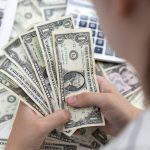
LONDON/TOKYO (Reuters) -The pound slipped against the dollar on Thursday ahead of a Bank of England (BoE) policy meeting, while hawkish opinions from Bank of Japan (BOJ) members helped slow the yen’s fall.
The dollar index rose as traders start to focus on U.S. inflation data due next week and its implications for Federal Reserve policy.
Sterling fell 0.2% to $1.2472, moving away from a three-week high of $1.2709 touched last week. The BoE is expected to hold rates steady but flag when it intends to lower the cost of borrowing as inflation falls.
According to LSEG data, money markets are pricing in a 96% chance that the central bank will hold its benchmark interest rate at 5.25% when it meets at 1100 GMT – the highest since 2008. But investors will be watching for signs to firm their expectations on when cuts could come.
Markets now see a 55% chance of a BoE cut in June – when the European Central Bank has signalled it will reduce borrowing costs, and a greater chance, 72%, of a BoE rate cut in August.
“The big question is whether sterling should be priced closer to the Fed (and) dollar cycle or closer to the ECB (and)euro. It may be too early for the BoE to signal a June hike today, but we see downside risks to the pound,” said Chris Turner, head of markets at ING.
Against the Japanese yen, the dollar has been slowly inching up after it fell 3.4% last week, its biggest weekly percentage drop since early December 2022.
The yen was 0.2 lower on the day at 155.87 per dollar, with the Japanese currency briefly finding some support in the BOJ’s summary of opinions released on Thursday, which showed board members were overwhelmingly hawkish at their April policy meeting, with many calling for steady interest rates hikes.
The “BOJ appears to be hinting at the next rate hike, which could come in June or July as final results of wage negotiations come out,” said Charu Chanana, head of currency strategy at Saxo.
Last week’s Fed policy meeting and downside surprise in U.S. job growth have markets increasing bets for two rate cuts this year. But a chasm remains between Japan’s ultra-low yields and those in the United States.
Japan’s top currency diplomat Masato Kanda on Thursday reiterated a warning that Tokyo is ready to take action in the currency market.
Market players suspect Tokyo spent some $60 billion last week to stem the yen’s slide after it hit its weakest in 34-years against the dollar around 160 yen.
The dollar index, which measures the greenback against a basket of currencies including the yen and the euro, rose 0.18% to 105.70, having touched a one-week high earlier.
Traders will be closely watching April U.S. producer price index (PPI) and the consumer price index (CPI) out next week for signs that inflation has resumed its downward trend toward the Fed’s 2% target rate.
Elsewhere, China’s offshore yuan was flat on the day at 7.2321, as data revealed China’s exports and imports returned to growth in April after contracting in the previous month.
That could mean a potential delay for rate cuts some believed China would need to make to meet its 2024 GDP goal.
To read the full article, Click Here

